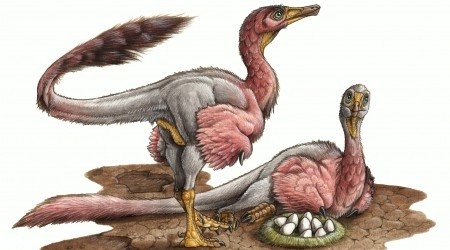Eggs of Mysterious Bird-Like Dinosaur Discovered in Patagonia

Scientists have discovered the remains of a mysterious bird-like dinosaur that lived 70 million years ago in Rio Negro province of Argentine Patagonia.
A team of Argentine and Swedish paleontologists found two alvarezsaurid dinosaur eggs preserved along with bones which is believed to be of the mother. The cause of her death is still a mystery to the researchers.
The dinosaur was named Bonapartenykus ultimus in honor of Jose Bonaparte, who discovered the first alvarezsaurid in Patagonia in 1991.
The mysterious dinosaur was said to have measured at least 2.6 m (8.5 feet) long and was one of the largest members of the family. The dinosaur represents the last survivors of its kind from Gondwana, the southern landmass in the Mesozoic Era.
Alvarezsaurid theropods were usually small (0.5-2.5 m) bipedal feathered dinosaurs known from Asia, North and South America. They had a bird-like skull and tiny teeth-carrying jaws. They also had considerably abbreviated forearms.
The dinosaur eggs were found less than 7.9 inches (20 centimeters) from the partial skeleton and seemed to belong to that of individual dinosaur. The researchers ruled out a postmortem mixing that brought the two together. The partial skeleton was also articulated, which would likely not be the case if they had been transferred there after death, reported Live Science.
According to Martin Kundrat of Uppsala University, the two eggs found together with the bones during the expedition might have been inside the oviducts of the female when the animal perished.
"So it looks like we have indirect evidence for keeping two eggs in two oviducts," Kundrát told LiveScience. "They were close to being laid, but the female didn't make it."
The researchers also found numerous eggshell fragments that were found to show considerable calcite resorption of the inner eggshell layer, which suggest that at least some of the eggs were incubated and contained embryos at an advanced stage of their development, Science Daily reported.
They noticed the eggshell fragments had the fossilized fungi. Such contamination affects bird eggs today, Kundrat said.
"It looks like at the very late stage the eggs could suffer from the same contamination as in common birds," he told Live Science during a telephone interview.
"It doesn't mean it must kill the embryo, because usually in the embryonic space or inner space it's still protected by a very dense network of organic fibers called the shell membrane," he added.
The report has been published in the journal Cretaceous Research
© Copyright IBTimes 2025. All rights reserved.





















